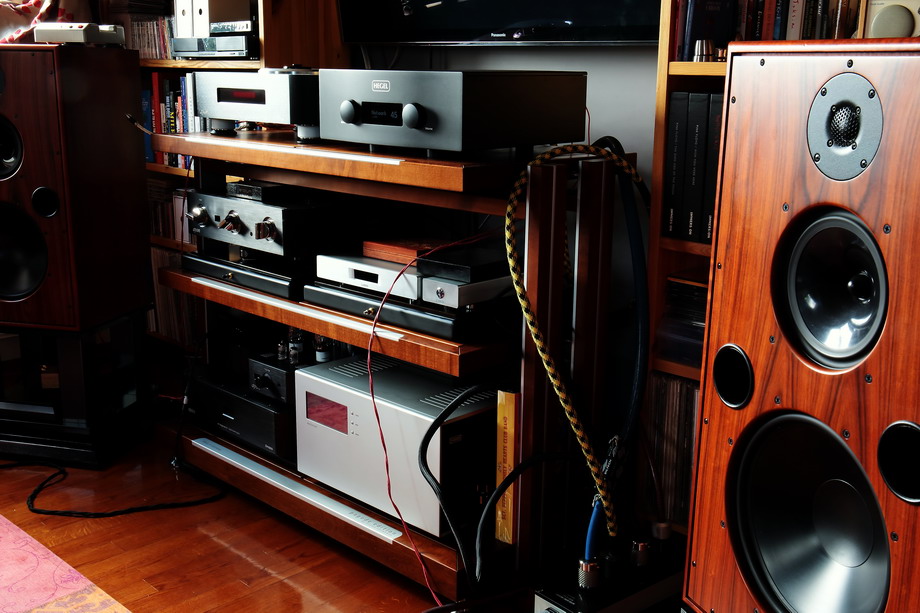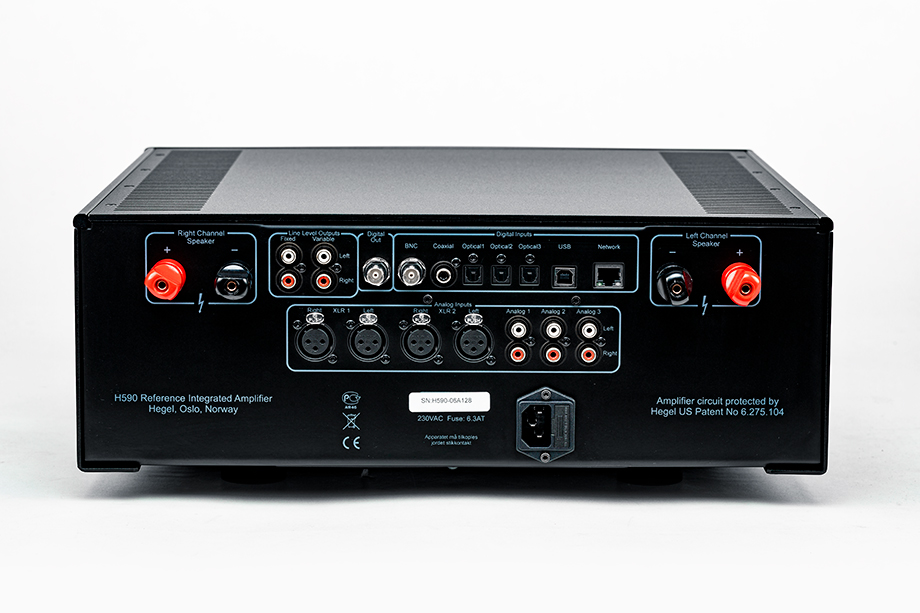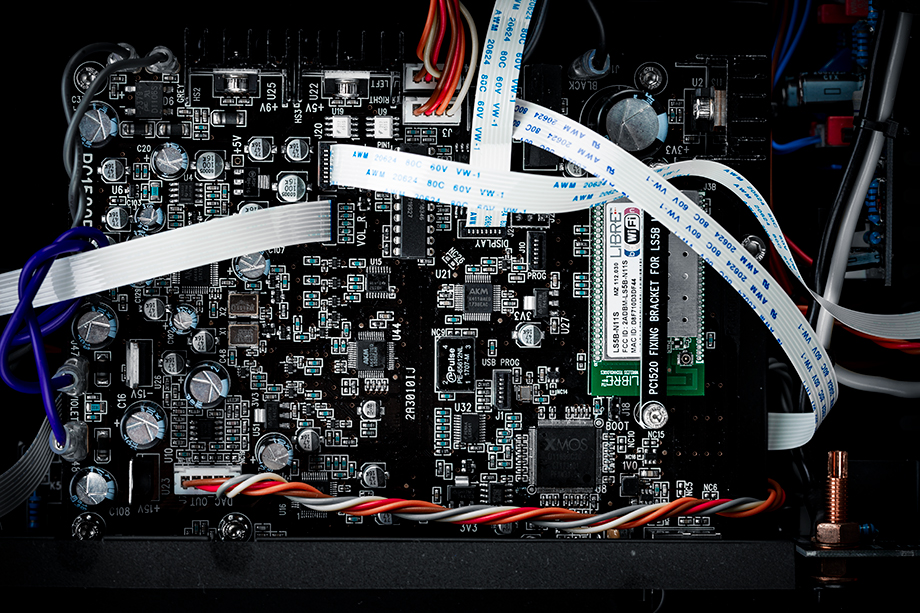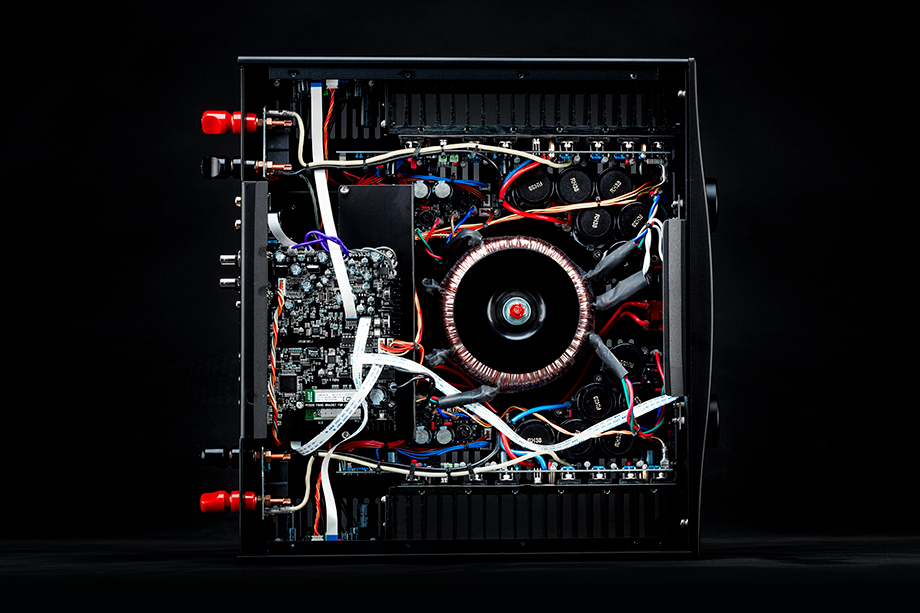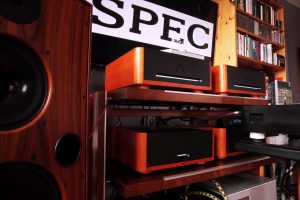The H590 is an extremely important device for Hegel Music Systems. Basing only on the description, it would seem very similar to the H190 model, which we reviewed in High Fidelity, and it was featured on our cover, in November last year (HF | No. 163). Even comparing their features would suggest these are very similar devices—an integrated amplifier—combined with a digital-to-analog converter and streamer.
However, the tested amplifier is more than just an integrated integrated amplifier—this type of device is often called "super-integrated." This type includes expensive and very expensive integrated amplifiers, costing as much as set of separates—a preamplifier and a power amplifier. That is why the H590 is not only the biggest amplifier of this type in Hegel's lineup, but also the most powerful one. Although there are even more powerful integrated amps on the market, the Hi-Fi News magazine in their test names Perreaux 255i (435W / 8Ω), Marantz PM-10 (620W / 8Ω) and McIntosh MA9000 (410W / 8Ω), but the output of the H590, i.e. 319W at 8 and 590W at 4Ω (values measured by HFN) is really impressive. I assume it will be enough in every system. All the more so because for the 2Ω load in dynamic conditions the amplifier will deliver an incredible output of 2.24kW!
H590
Bent Holter, th owner and chief engineer of the company, says that the development of the new amplifier started in the spring of 2017. It was supposed to be based on a completely new platform - all previous amplifiers were based on solutions developed for the H4 amplifier and, to a lesser extent, H200. The new device, the H590, was named a "big brother." The work involved designing, measurements, auditions, and corrections. And so on and on. Old, but excellent, modular, IRS Beta loudspeakers with a planar high-midrange and classic woofer section were used for the tests.
The final result of all that work is the H590 super-integrated This is primarily an integrated amplifier with five analog inputs, two of them are symmetrical (XLR), and three are unbalanced (RCA), as well as two analog outputs—one with fixed and the other with adjustable signal levels. It's a dual-mono design, which applies not only to the output stage but also to the preamplifier. Since we already close to an end of the second decade of the 21st century, the "integrated amplifier" often means something other than—say—NAD 3020 back in the day. Since the introduction of the Röst and H190 models, Hegel amplifiers are fully integrated with the file players and are equipped with a digital-to-analog converter, hence the presence of not only analogue but also digital inputs in the tested device.
The latter section of the device is worth attention, because it is not just a fancy feature. Although the company does not inform about it officially, it's something like an external DAC but implemented inside the amplifier. There are some solutions known from both the DA30 and the Mohican CD player here, and another upside—one doesn't need additional cables power nor IC since the DAC is inside the integrated. The development of the converter took quite a long time, because the objective was to make the music played from a computer or an external hard disk - through the UPnP protocol—sound equally well as played from a CD.
The number of inputs should satisfy even very demanding music lovers and audiophiles—there is a total of seven inputs: three optical TOSLinks, two coaxial ones—BNC and RCA—USB and RJ-45, or LAN. In addition, the system communicates wirelessly with Apple devices, via the AirPlay protocol modified by Hegel. Unfortunately, the manufacturer does not specify the upper sampling frequencies of individual inputs or file formats supported by the player section. It is only known that the USB input accepts PCM signal up to 24/384 and DSD256, as well as MQA signal that is decoded in the amplifier.
Tidal | MQA
The file player in the H590 is actually a Raspberry Pi microcomputer, popular among DIY community because it is inexpensive and extremely easy to use. For control one can use one of several free UPnP applications. However, it has limitations, such as lack of support for the Tidal service and MQA files. It may change in the future, it is a computer so a new software might become available one day, but for now Hegel came up with a different solution - MQA files can be decoded when sent via USB input from a computer. The computer works as a streamer, and the digital section in the amplifier as a decoder and DAC. In order to make the most of the potential of such files, the manufacturer created a path separated from other inputs.
For the particularly sophisticated audiophiles, an interesting technical solution has been developed—an external digital-to-analog converter can be connected to the H590, working in the loop with the amplifier. This means that all digital cables are connected to Hegel, and the signal is still decoded in the external DAC anyway. In this case, its analog output must be connected to the XLR1 input of the amplifier. It's really convenient, because the system will only need one remote control to change inputs—the amplifier's.
But it is still not all, because Hegel has developed many of his own technical solutions and—like other well-known companies—gave them their proprietary names. H590 features following ones:
- DualAmp Technology from Hegel separates the voltage gain stage and the current gain stage into two completely different stages. First the music signal goes to the voltage gain stage, amplifying only the voltage level of the music signal. After the separate voltage gain stage, we have the current gain stage, doing only current gain and nothing else,
- DualPower, which mean separate power supplies for the input and voltage gain stages, and for the current output stages of the audio amplifier. The custom designed Hegel power transformers have got separate DualPower windings feeding independent high speed rectifiers and high capacity power supply capacitors,
- Organic Sound, that describes the main goal of the manufacturer,
- SoundEngine, a system that reduces crossover distortions, created when the amplified signal goes through zero, making the device operation similar to the one of class A, despite the fact that it actually operates in the AB class. This solution is called adaptive feed forward technology, meaning a system in which the signal is sent to the output of the system, not to the input,
- synchroDAC is a new digital to analog conversion technology called synchronized upsampling, introduced for the first time with the Mohican CD Player,
- MQA (Master Quality Authenticated), decoding of the MQA files from Tidal,
- USB (self-explanatory).
The only feature left out this time is the headphone output—you won't find one here. There is however an option of an upgrade of the software via the Ethernet input. Hegel already offered an upgrade of the remote control software, as well as the option of using volume control in ROON when using the USB input. Soon Hegel should also obtain a certificate for Spotify. As soon as it is ready, a software upgrade will be made available.
TEST METHODOLOGY
The H590 was tested in High Fidelity's reference system and compared to separates: Ayon Audio Spheris III and Soulution 710. The source was Ayon Audio CD-35 HF Edition (No. 01/50); the amplifier drove Harbeth M40.1.
The H590 is equipped with XLR inputs, but I almost always get better sound using the RCA inputs - it was the case also this time. The problem was that the RCA inputs in Hegel are of medium quality and are positioned close to each other, which excluded the possibility of using Siltech Triple Crown interconnects. So I used the Acoustic Revive Absolute Triple-C interconnects. The amplifier was placed on the top shelf of the Finite Elemente Pagode Edition rack, and I placed the Verictum X Block EMI / RFI noise filter on top of it above transformer.
Files were played through the router from Synology NAS drive. For control I used the recommended application, ie Linn Kinsky. The Ayon Audio player was used to check the quality of digital RCA input.
SOUND
Recordings used for the test (a selection)
- Bill Evans Trio, Portrait in Jazz, Riverside/Fantasy RISA-1162-6, SACD/CD (1959/2003)
- Depeche Mode A Broken Frame, Mute/Warner-Pioneer Corporation 18P2-2676, CD (1982/1989)
- Dire Straits, Brothers in Arms, Vertigo/Mobile Fidelity Labs UDSACD 2099, "Original Master Recording, Special Limited Edition | No. 1808", SACD/CD (1985/2013)
- Hans Koller, Retrospection Three, Stoney Lane Records SLR1920, "Promotional Copy", CD-R (2016)
- Maroon 5, Red Pill Blues, 222 Records/Interscope 6705300, 2 x CD (2017)
- Mayo Nakano Piano Trio, MIWAKU, Briphonic BRPN-7007GL, Extreme Hard Glass CD-R (2017); more HERE
- Tomita, Snowflakes Are Dancing, RCA Red Seal/BMG Classics 63588, "High Performance Series", CD (1974/2000)
- Tsuyoshi Yamamoto Trio, Midnight Sugar, Three Blind Mice/Impex Records IMP8308, Gold HDCD (1974/2004)
- West 8th Street, West 8th Street on Castle Ave., Audio Lab. Record/Octavia Records OVGL-00025, SACD/CD (1976/2012)
The H590 is aimed at advanced audiophiles, music lovers and music fans. Its price directs us to areas where trinkets, gadgets have less and less importance and eventually lose any. What matters is only the performance. Above all of the amplifier, because it is the primary function here.
Amplifier
The top integrated by Hegel is a very resolving device. Truly remarkably resolving. I have not heard so many details and information from a solid-state device for a long time. I was also a while since, regardless of the technology, I have heard so well presented reverb and the acoustics accompanying instruments and voices. It's a master of extracting information from recordings, presenting even minor changes.
Its tonal balance is shifted up compared to other Hegel amplifiers that I have listened to before. Like most other powerful, expensive amplifiers, it does not manifest its power, it does not kill us with bass. When needed, bass is nicely extended and be perfectly controlled, reminding me of what I have heard in some good recording studios with active speakers. Because it is a direction that its sound takes—towards momentum, energy and pace.
The H590 seems to me a clear declaration of the manufacturer, because it does not go in the direction of tube warmth and smoothing the attack so that some people would "like it." It's about experiencing music, about emotional participation, about getting into that sound. This is not just a re-creation, but an attempt to re-experience emotions.
As already mentioned, this is an amplifier with remarkable resolution. For a moment, I was worried about how would some "mass market" recordings sound like, i.e. with extensive production and strong compression. It turned out that there was nothing to fear, because—for example—the latest album by Maroon 5 Red Pill Blues was presented as it was, which means the most important element was the perfect, flawless production. It was a pure sound with deep perspective and well-laid out elements in a wide panorama unfolded in front of me.
The soundstage itself was deep and shown somewhat farther away from me than by other Hegel amplifiers. It is much better organized and clearer—the remarkable resolution and selectivity of the H590 did their job again. But you should not expect that vocals will be pushed forward, or particularly palpable. This is not the case. Hegel creates an impressive, very large space, therefore it does not focus on the listening axis. I would even say that in its presentation it is more important to show the depth of the stage rather than reproduce 3D bodies.
It is a master of purity. Nothing in its performance irritates listener, there is no brightness of the treble and it is immediately clear that with the proper combination of speakers and cables, we can use this feature to better understand what was recorded, to extract even more information from the disc (files). If this is what you are looking for, if you think that other amplifiers are playing in a somewhat muddy way, that they have too little life in them, Hegel H590 will be your dream come true. If, in turn, you are looking for warmth, "tubes", richness, slightly emphasized vocals, you will have to look elsewhere, maybe actually among tube amps.
DAC
This is a device where the DAC function is as important as the amplifier. It offers everything that you need from such a device, and what is usually missing when it comes to integrated amplifiers, above all resolution. It's a converter that perfectly conveys dynamic spikes, tone differentiation, bandwidth extension. It will deliver both resonant, powerful cymbals and deep, perfectly controlled bass. The latter is so precise that some of the discs will sound as if you heard them for the first time.
This DAC puts in question the point of using an external converter from the price range of 10,000 - 20,000 PLN with H590. Sure, you could find some that would have some advantages—for example, a deeper soundstage or resolution—but the differences won't be significant, and at the same time you will lose some advantages of what we get together with this amplifier.
Music files player
I am writing about files player at the end not because it is the weakest link of the reviewed device. In truth, all three elements offer similar sound quality and—most importantly—the same character. Music played in this way is dynamic, powerful, open. These are the same features that I've already attributed to the amplifier and DAC, but I have no choice. Playing files will thus resemble performance achieved with external analog and digital sources. Power, dynamics, momentum, huge soundstage—things that are difficult to achieve with files are available here from the start.
Bent Holter, the owner of Hegel and its chief engineer, in company materials, points out that the PCM 16 / 44.1 signal, i.e. of the same resolution as from a CD, is treated in a special way by the internal player and converter in the H590, and I can confirm it. High resolution files are a bit better, but it was the files ripped from the CDs that sounded particularly good.
Summary
The first super-integrated amplifier in Hegel's history had to be something special. And it is. It also had to stand out, differ from other products of this manufacturer. And it does. It is super-dynamic, super-precise and super-resolving. What's more—each of its components delivers similar performance, does not modify the sound. The digital-to-analog converter deserves particular attention. Being an owner of the H590, I would not feel the need to buy, for example, the HD30 external DAC. Same goes for the files player.
The basic element, however, is the amplifier. Let's be clear—it controls the speakers better than most amps. It does not impose bass on us, but when it appears in the recording, it is shown in a very clear, selective fashion. But also, that's the other side of the coin, it is not an amplifier that tempts listeners with richness, warmth. It does not present strong, big foreground, but rather a huge space with remarkable depth. The image won't be particularly three-dimensional either. As always, it's a matter of choice. But that's what audio is about. Hegel has given you options that you won't find anywhere else.
DESIGN
H590 is the largest integrated amplifier from Hegel. It is bigger than all others—it measures 430 x 171 x 445 mm—and heavier with its 22 kg. It is an amplifier equipped with a digital-to-analog converter and integrated with a file player.
Front and rear
Despite offering so many functions, the amplifier has an extremely clean line—a feature that is extremely attractive. If we forgot about its height, it could be confused with any other device from this manufacturer. On the front panel there are only two large knobs—volume control and input selector—and an alphanumeric OLED display—nice and clear. It allows user to read out all the necessary information, such as the selected source, volume level and LAN connection status. With the volume knob one changes the volume level in one hundred 1 dB steps - from 0 to 99, where '0' represents mute and '99' maximum volume.
The H590 is controlled by a microprocessor, which allows it to be "armed" with several useful features. If we use the remote control, we can set the maximum volume (protection against children and for parties) and the starting volume level of the device it turns on with, and also turn off the display.
We can find out more by taking a look at the back of the amplifier. We find the input and output sockets grouped in sections. They are of good quality, but nothing stands out—XLR sockets are gold plated, and RCA's have only gold-plated ground contact. On the other hand, loudspeaker connectors made entirely of copper look great. The chassis was made of aluminum plates bolted together because manufacturer tried to minimize the amount of steel in the vicinity of electronic circuits. The device features four small feet.
Inside
The design of the H590 clearly suggests that we are dealing with three separate devices in one housing: a preamplifier, a power amplifier and a file player and a D / A converter, treated as a whole. The DAC / player and the input section are separated from each other by thick steel screens that also stiffen the PCBs.
DAC/files player | The section of the player and DAC uses a common PCB, although it is powered separately. On the right side (as seen from the back) there is a file player and USB input—they are treated as similar inputs. Next to the USB there is a XMOS chip that is responsible for the USB signal conversion, and next to the Ethernet input there is a small microcomputer, also providing wireless connectivity—the amplifier connects to Apple devices via the AirPlay protocol, modified by Hegel engineers—and the file player.
Due to the presence of the Ethernet input the software of this section may be replaced/upgraded in the future, and the amplifier is adapted to cooperate within Control4 - a two-way control network. This section ends with the AKM AK4118 digital receiver and to further reduce the interference with the other inputs, it is separated with a transformer.
The other digital inputs use a separate digital receiver, another AKM. From both systems, the signal is routed to the Asahi Kasei Microdevices Corporation (AKM) sampling frequency converter AK4137EQ. This is the company's flagship device, converting the digital signal to 32-bits. I have not found any information on this subject, but it seems that the DSD signal, previously converted to PCM, is also upsampled. So prepared it is sent to the AK4493EQ digital-to-analog converter.
According to the Japanese manufacturer's materials, it is their best-selling, high-end DAC, launched in January this year. It belongs to the top Velvet Sound series and it decodes PCM signal with 32-bit precision and sampling frequency up to 768 kHz for PCM and 22.4 MHz for DSD. Let me remind you that the H190 featured an older DAC, AK4490EQ. Next to "DAC" there are two nice clocks that are part of the company's Direct MasterClock.
Preamplifier
The Microchip micro-controller and volume control are in the digital section, although the volume control is done in analog domain. This is a dual-mono preamplifier, there is a separate PCB for each channel, bolted to the side walls, just before the power amplifiers. The preamplifier received a separate toroidal transformer, and thus a complete power supply. The preamplifier was built using transistors. Signals from XLR inputs are desymmetrized in integrated circuits, and the inputs are switched using relays.
Power amplifier
Also the power amplifier is a dual-mono design, with separate amplifier boards, and also a power supply's. What's more, the input section has additional, separate power supplies. Common to them is the primary winding of a very large toroidal transformer. This section is equipped with good, threaded electronic components, including WIMA and Rubycon capacitors. Multi-legged SE3090 circuits are placed in the input—this is the SoundEngine2 system. Each channel uses six complementary pairs of fast, high-current bipolar Toshiba 2SA2121 + 2SC5949 transistors. They operate in the AB class in push-pull mode.
Remote
The same remote control that we already know from the H190, the RC8 model was selected for the H590. It has a solid, metal body and small buttons of identical size. They give user access to the control not only of the amplifier, but also Hegel's CD players as well as playback of computer files. With its help, we can also turn off the display, mute the volume, and set one of the analog inputs as so-called. "Pass through," when H590 is to be used as part of a home cinema system.
Technical specifications (according to manufacturer)
- Output: 2 x 310 W/8 Ω | 2 x 590 W/4 Ω
- Minimal load: 2 Ω
- S/N ratio: >100 dB
- THD: < 0.005% (p = 50 W/8 Ω, f = 1 kHz)
- Intermodulation (19 kHz + 20 kHz): < 0,01%
- Damping factor: >4000
- Frequency range: 5 Hz - 100 kHz
- Crosstalk: <-100 dB
- Analog inputs: 2 x balanced XLR, 3 x unbalanced RCA
- Digital inputs: 1 x RCA S/PDIF, 3 x TOSLink S/PDIF, 1 x USB, 1 x RJ45
- Dimensions (W x H x D): 430 x 445 x 171 mm
- Weight: 22 kg
Measurements taken by Hi-Fi News, October 2018
Price (in Poland): 44 000 PLN
HEGEL MUSIC SYSTEM
P.O. Box 2 Torshov
NO-0412 Oslo | Norway
DESIGNED IN NORWAY
Provided for test by: CAMAX
Text: Wojciech Pacuła
Images: Piksel Studio/Bartosz Łuczak | Wojciech Pacuła






